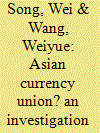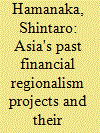| Srl | Item |
| 1 |
ID:
093650


|
|
|
|
|
| Publication |
2009.
|
| Summary/Abstract |
This paper applies Optimum Currency Area (OCA) theory to investigate the suitability of Asian currency union and its membership, in which China is taken as the central country. Cluster analysis is applied for this study. Both hierarchical clustering and fuzzy clustering approaches are used. The study finds that Japan, Korea, Hong Kong, Malaysia, Philippines, Singapore, Thailand, Cambodia and Vietnam are most converged with China, and these countries are more likely to be the member countries of the Asian Currency Union.
|
|
|
|
|
|
|
|
|
|
|
|
|
|
|
|
| 2 |
ID:
105313


|
|
|
|
|
| Publication |
2011.
|
| Summary/Abstract |
This article analyzes five significant institutional variables related to membership and control of institutions, using comparative case studies of Asia's past regional financial projects from the 1950s through the 1990s. The five variables are: (i) countries included in or excluded from membership, (ii) membership tiers, (iii) institutional decision-making process, (iv) executive positions at organizational structure (e.g. secretariat and headquarters) of institutions, and (v) the location of the secretariat/headquarters. Past financial regionalism projects hold several important lessons for current initiatives. First, in the case of regional financial institutions, "inclusion in membership but exclusion from regional membership" is a possible option and it is crucial to go beyond the simple debate on the membership problem, namely inclusion and exclusion, when designing a regional financial institution. Second, no single country should dominate the decision-making process by voting power-an institution must maintain a delicate balance among its members in terms of voting. And finally, key to determining the success or failure of regional financial institutions is which country hosts the secretariat/headquarters and sends staff to the executive positions.
|
|
|
|
|
|
|
|
|
|
|
|
|
|
|
|